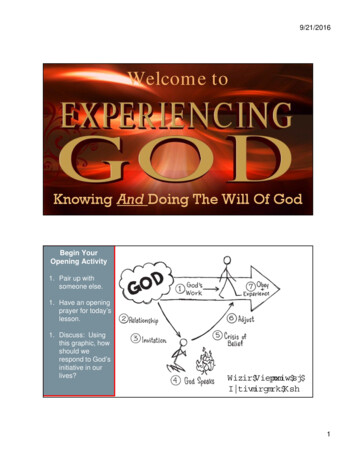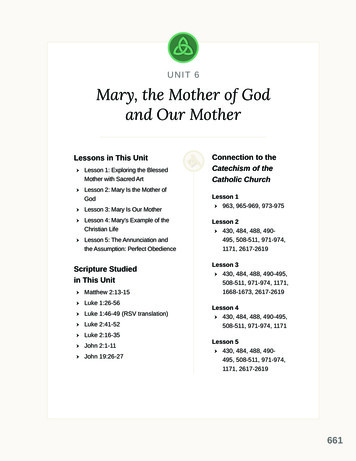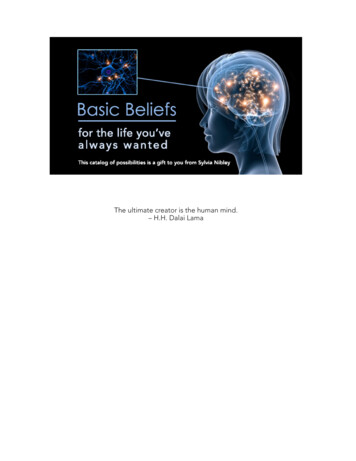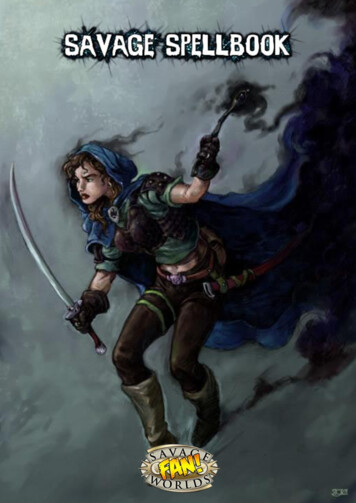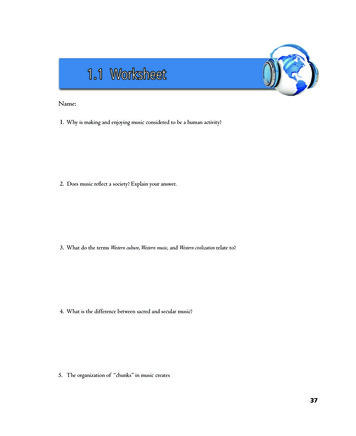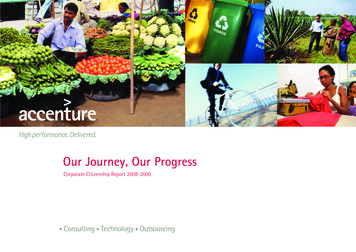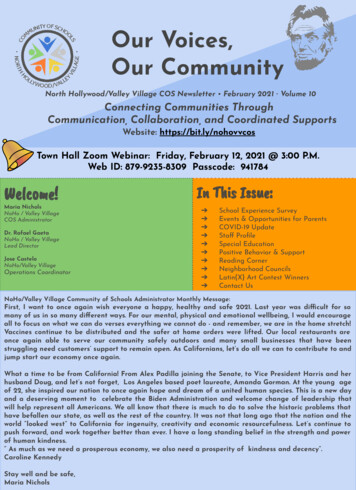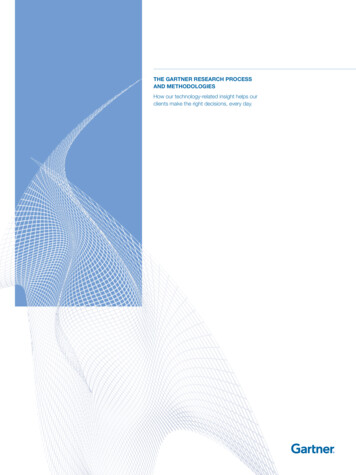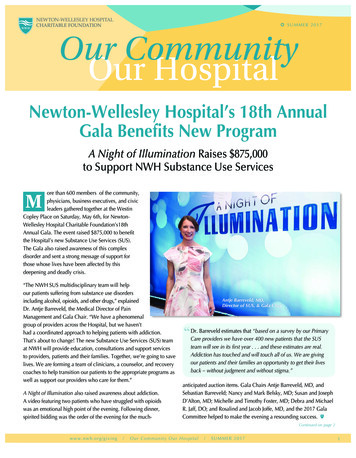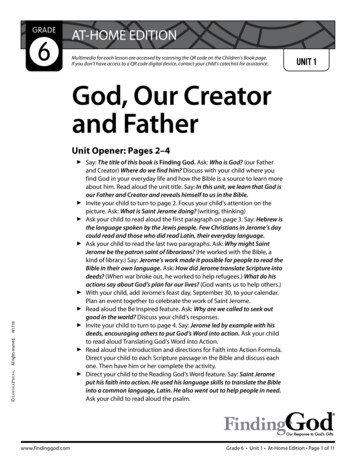
Transcription
GRADE6AT-HOME EDITIONMultimedia for each lesson are accessed by scanning the QR code on the Children’s Book page.If you don’t have access to a QR code digital device, contact your child’s catechist for assistance.UNIT 1God, Our Creatorand FatherUnit Opener: Pages 2–4 All rights reserved. W1718 Say: The title of this book is Finding God. Ask: Who is God? (our Fatherand Creator) Where do we find him? Discuss with your child where youfind God in your everyday life and how the Bible is a source to learn moreabout him. Read aloud the unit title. Say: In this unit, we learn that God isour Father and Creator and reveals himself to us in the Bible.Invite your child to turn to page 2. Focus your child’s attention on thepicture. Ask: What is Saint Jerome doing? (writing, thinking)Ask your child to read aloud the first paragraph on page 3. Say: Hebrew isthe language spoken by the Jewis people. Few Christians in Jerome’s daycould read and those who did read Latin, their everyday language.Ask your child to read the last two paragraphs. Ask: Why might SaintJerome be the patron saint of librarians? (He worked with the Bible, akind of library.) Say: Jerome’s work made it possible for people to read theBible in their own language. Ask: How did Jerome translate Scripture intodeeds? (When war broke out, he worked to help refugees.) What do hisactions say about God’s plan for our lives? (God wants us to help others.)With your child, add Jerome’s feast day, September 30, to your calendar.Plan an event together to celebrate the work of Saint Jerome.Read aloud the Be Inspired feature. Ask: Why are we called to seek outgood in the world? Discuss your child’s responses.Invite your child to turn to page 4. Say: Jerome led by example with hisdeeds, encouraging others to put God’s Word into action. Ask your childto read aloud Translating God’s Word into Action.Read aloud the introduction and directions for Faith into Action Formula.Direct your child to each Scripture passage in the Bible and discuss eachone. Then have him or her complete the activity.Direct your child to the Reading God’s Word feature. Say: Saint Jeromeput his faith into action. He used his language skills to translate the Bibleinto a common language, Latin. He also went out to help people in need.Ask your child to read aloud the psalm.Our Response to God’s Giftswww.findinggod.com Grade 6 Unit 1 At-Home Edition Page 1 of 11
GRADEAT-HOME EDITION6UNIT 1SESSION 1The Bible, God’s StoryEngage: Page 5 Invite your child to quiet himself or herself and prepare to hear Sacred Scripture.Read aloud Luke 34:27–32. Then say: The Gospel of the Lord. Invite your child to respondPraise to you, Lord Jesus Christ.Invite your child to think of some things he or she knows about his or her best friend.Ask: How did you learn these things? (Answers will vary.) Say: We learn about God fromhis words and actions revealed in the Bible. Ask your child to read aloud the text onpage 5. Say: We can grow closer to God by reading the Bible.Explore: Pages 6–7 All rights reserved. W1718 Discuss pieces of art you and your child are familiar with. Ask: What might have inspiredthe artist to make such a piece? Look up inspired in the Glossary and read the definition.Have your child read aloud page 6. Ask: What is the main story of the Old Testament?(the story of how God revealed himself to the Hebrew people and how they placedtheir faith in God) What is the main story of the New Testament? (the story of how Godthe Father revealed himself fully in Jesus, his Son; the early Christians; and their newfaith and salvation through Jesus)Read aloud the Did You Know? feature. Discuss some of the books of the Bible you areboth familiar with and tell what you know about them.Have your child read aloud page 7. Discuss the terms Magisterium and interpretation.Say: The Bible is the Word of God. God reveals himself to us through Scripture andChurch Tradition. The Holy Spirit works through the Magisterium, who help usunderstand what Scripture means for our lives.Read aloud the Reading God’s Word feature. Ask: What does this Bible verse mean to you?Art Exploration: Page 8 Find in a magazine, a book, or online a picture of an illuminated, or decorated, Bible page.Say: What do you see in this picture? Encourage your child to describe the picture indetail, including letters, pictures, and scenes.Ask: Why do you think those who copied the Bible wanted it to be so beautiful? (Possibleanswer: to show the beauty of God’s Word)Have your child turn to page 8. Read aloud the introduction and discuss the question.Invite your child to read aloud Copying the Bible. Point out the two bolded words. Ask:Why is “everyday language” important for a Bible translation? (makes it easier to read)Why were scriptoriums important? (They produced copies of the Bible so that morepeople could use the Bible for prayer and worship.)Have your child read aloud Illuminated Bible and complete the activity.Our Response to God’s Giftswww.findinggod.com Grade 6 Unit 1, Session 1 At-Home Edition Page 2 of 11
GRADEAT-HOME EDITION6UNIT 1SESSION 1 Ask your child to study the illuminated Bible page and imagine what it would take tocopy not only the Scripture, but also to illuminate the page. Have your child reflecton how long it would take to copy the page and focus on the concentration theilluminators must have had to complete each page. Close with a silent prayer thankingGod for revealing himself through the Bible.Reflect: Pages 9–10 Together look at page 9. Say: Praying is different from reading or reciting. A prayer is aconversation. Think about the words you are praying and listen with your heart.Have your child read aloud the paragraph on page 6. Then pray aloud the prayertogether. Guide your child to understand that you will pray the verse, they will respondwith the refrain, and you will pray together the second paragraph. Conclude by prayingAmen and joining your child in making the Sign of the Cross.Have your child read aloud Making Choices on page 10. Ask: How can we use free will tofollow God and do good in the world? (Answers will vary.)Have your child read aloud Seeking Advice and think of a situation to write about.Discuss the situation and response after he or she is finished writing.Respond: Pages 11–12 All rights reserved. W1718 Ask your child to read aloud the Faith Summary on page 11. Review the Words I Learnedin this session. Read aloud Ways of Being Like Jesus. Invite your child to choose one ofthe psalms listed and read it aloud together.Say: Let’s give thanks for the gift of God’s Word. Read aloud the prayer as your childfollows along. Pray the Sign of the Cross together.Read aloud With My Family on page 12. Together as a family, complete the page anddo the activity. Pray the family prayer together. Say: With the guidance of God’s Wordand the Holy Spirit, we can live our lives as witness to the Good News and build Christ’sChurch.Our Response to God’s Giftswww.findinggod.com Grade 6 Unit 1 At-Home Edition Page 3 of 11
GRADEAT-HOME EDITION6UNIT 1SESSION 2God Creates the WorldEngage: Page 13 Invite your child to quiet himself or herself and prepare to hear Sacred Scripture.Read aloud Ephesians 2:4–10. Then say: The Word of the Lord. Invite your child torespond Thanks be to God.Invite your child to recall a news story with a dramatic rescue. Say: Think about a timewhen someone rescued you from a difficult situation. God the Father sent his Son,Jesus, to save us from sin because we are incapable of saving ourselves.Ask your child to read aloud the paragraphs on page 13. Ask: What can we do to receivegrace from God? (Nothing. It is given to us by God freely.)Say: Let’s thank Jesus for our salvation and ask for help to do his work. Pray aloud theprayer together. Conclude the prayer by praying Amen.Explore: Pages 14–15 All rights reserved. W1718 Together close your eyes and visualize something wonderful that God has created. Ask:What amazing things did you see? Make a list of your responses.Have your child read aloud the top sections of page 14. Ask: What did the writer of thefirst Genesis story want to make clear? (God created every part of the world and saweverything as good.)Have your child read aloud It’s All Good. Ask your child to name something that theytypically think of as bad but ask them to tell you something good about it. For example,forest fires seem bad but the fires remove underbrush and help new trees grow. Thenhave your child to complete the activity.Read aloud page 15. Ask: What was it like for the exiled Jews? (They were treated badly.)Look up culture and racism in the Glossary. Discuss the definitions. Say: Most Americansare immigrants or the descendants of immigrants, so someone in our family might havehad to get used to a new culture and may have faced racism.Have your child read aloud the Meet a Saint feature. Ask: How do people working forminority rights do God’s work? (They care for others and treat others as equals.)Art Exploration: Page 16 Find in a magazine, a book, or online a picture of Adam and Eve being expelled fromthe Garden of Eden.Ask: What do you see in this picture? Encourage your child to describe the picture indetail, including any emotion being expressed by Adam and Eve. Ask: How would youfeel if you were told to leave the place where you lived? (Answers will vary.)Our Response to God’s Giftswww.findinggod.com Grade 6 Unit 1, Session 2 At-Home Edition Page 4 of 11
GRADEAT-HOME EDITION6UNIT 1SESSION 2 Have your child turn to page 16. Read aloud the introduction and discuss the question.Read aloud The Second Story of Creation. Ask: What does God ask of us today? (to carefor the earth) How did God show mercy to Adam and Eve? Discuss stewardship.Have your child read aloud Mercy and Love and write a prayer.Read aloud the Reading God’s Word feature. Ask your child to explain Psalm 8 in his orher own words. Say: Psalm 8 praises God for making human beings so special.Ask your child to create a comic strip panel to tell one creation story. When it is finished,encourage them to share it with a family member.Reflect: Pages 17–18 Together look at page 17. Ask: What do you see in the picture? (a family enjoying nature)Say: God’s gift of creation was an act of tremendous love.Read aloud the first four paragraphs on page 17. Allow time for your child to imaginethe vast richness of God’s creation. Then pray together the prayer slowly and withexpression. Close the prayer by praying Amen and praying the Sign of the Cross.Read aloud Equal in the Eyes of God on page 18. Point out the bolded word. Ask:What is our duty as Catholics regarding sexism and racism? (to oppose any kind ofdiscrimination)Have your child read aloud We Can Be Good and complete the activity. Discuss theresponse and drawing with other family members.Respond: Pages 19–20 All rights reserved. W1718 Ask your child to read aloud the Faith Summary. Review the Words I Learned in thissession. Read aloud Ways of Being Like Jesus. Ask your child to suggest specific ways heor she can be kind to other people and care for God’s creation.Read aloud the prayer as your child follows along. Pray the Sign of the Cross together.Read aloud With My Family on page 20. Together as a family, complete the page anddo the activity. Pray the family prayer. Say: Remember that God made you in his image.He created your body as well as your immortal. It is our destiny to live in heaven withour Father. We are called to follow Jesus’ example by treating people as he would treatthem.Our Response to God’s Giftswww.findinggod.com Grade 6 Unit 1, Session 2 At-Home Edition Page 5 of 11
GRADEAT-HOME EDITION6UNIT 1SESSION 3Sin and SalvationEngage: Page 21 Together with your child, name people in your community that you trust such as apolice officer, a teacher, the crossing guard, and the next-door neighbor. Ask: Whatdo you trust each of these people to do for you? (Answers will vary.) Say: Our Fatherin heaven wants you to place your trust in him. When we follow his Law and Jesus’teachings, we are responding to his grace and are led to salvation.Invite your child to quiet him or herself and prepare to hear Sacred Scripture. Readaloud Romans 5:19–21. Then say: The Word of the Lord. Invite children to respondThanks be to God.Say: Sometimes we feel distance from people we love, and we need the help of someoneelse to bring us together. Ask: How did God eliminate the distance caused by sin? (bysending his only Son, Jesus)Pray aloud the prayer. Then conclude the prayer by praying the Sign of the Cross.Explore: Pages 22–23 All rights reserved. W1718 Discuss times that your child regretted a choice he or she made, such as telling a lie,not doing chores, or not sharing with a sibling. Ask: How did you feel? What were theconsequences?Have your child read aloud page 22. Point out the bolded term. Ask: Why do you thinkAdam and Eve ate the one fruit that God had forbidden them to eat? (They wanted tobe wise like God.) What were the consequences? (They had to leave the garden; theirlives became more challenging.)Read aloud the Reading God’s Word feature. Ask: What other word does enmity look orsound like? (enemy) What do you think the word enmity means? (hatred) Say: These arethe words God said to the snake before sending Adam and Eve out of the Garden of Eden.Have your child read aloud Cain and Abel on page 23. Say: God showed Cain mercy.Ask: What is mercy? (a kind and tolerant response to a difficult time)Have your child read aloud the directions for God’s Mercy and complete the activity.Discuss your child’s responses.Read aloud the Did You Know? feature. Say: Through the Holy Spirit, our consciencehelps us judge the moral qualities of our actions.Art Exploration: Page 24 Find in a magazine, a book, or online an interpretation of Noah building the ark.Say: What do you see in this picture? Encourage your child to describe the picture indetail, including what the ark looks like and who is boarding the ark.Our Response to God’s Giftswww.findinggod.com Grade 6 Unit 1, Session 3 At-Home Edition Page 6 of 11
GRADEAT-HOME EDITION6UNIT 1SESSION 3 Say: God showed mercy to Noah’s family, just as he showed to Adam and Eve, and justas he shows to us.Have your child turn to page 24. Read aloud the introduction and discuss the question.Have your child read aloud the story. Ask: Why did Noah and his family survive theflood? (The listened to God, obeyed God, trusted in God.)Read aloud God’s Promise. Ask: What was God’s promise to Noah? What does it meanfor us? (to never send such a flood again, to never give up on people) Have your childcomplete the activity.Read aloud the Link to Liturgy feature. Say: Noah and his family were thankful for God’smercy. During Mass, we give thanks for God’s mercy too.Identify the colors of the rainbow. Have your child use water color paints or pastels tomake a rainbow, demonstrating the correct color order. Have your child draw a cloudand write a promise he or she will make to God. Display the artwork in your home.Reflect: Pages 25–26 Together look at page 25. Point out the picture. Say: The girl looks peaceful just as wedo when we pray. Remember that we can ask Mary, our Blessed Mother, to support andhelp us as we present our needs to God.Invite your child to read aloud the paragraph on page 25. Say: Let’s pray aloud each lineof the Hail Mary together. After each line, we’ll read silently the sentences that followand think about what they mean. Conclude by praying the Sign of the Cross.Have your child read aloud God’s Mercy, Our Trust on page 26. Then read aloud thedirections for Words of Wisdom. Look up the Bible verses together and discuss theirmeaning. Then have your child write a poem in the Trust in the Lord activity. Invite yourchild to share the poem with you.Respond: Pages 27–28 Ask your child to read aloud the Faith Summary. Review the Words I Learned in thissession. Read aloud Ways of Being Like Jesus. Ask your child to suggest specific ways heor she can use verses from the Scriptures to strengthen his or her faith in God.Read aloud the prayer as your child follows along. Then Pray the Sign of the Crosstogether.Read aloud With My Family on page 28. Together as a family, complete the page and dothe activity. Then pray the family prayer together. Say: We sin when we fail to trust Godand choose to disobey his law. It hurts our relationship with him and others. You canalways pray to the Holy Spirit for strength to live as Jesus wants us to live. All rights reserved. W1718 Our Response to God’s Giftswww.findinggod.com Grade 6 Unit 1, Session 3 At-Home Edition Page 7 of 11
GRADEAT-HOME EDITION6UNIT 1SESSION 4Abraham Listens to GodEngage: Page 29 Together with your child, talk about difficult tasks both of you have completed. Ask: Didyou need help to overcome the challenges of completing the task?Invite your child to quiet him or herself and prepare to hear Sacred Scripture. Readaloud Acts of the Apostles 3:13–16. Then say: The Word of the Lord. Invite children torespond Thanks be to God.Ask your child whom they would trust to come through for them if they were desperatefor help. Have your child read aloud the paragraphs on page 29. Say: When we facechallenges as we serve God and others, we can always pray and ask God for help.Pray the prayer together. Then conclude by praying the Sign of the Cross.Explore: Pages 30–31 All rights reserved. W1718 Have your child make two columns on a sheet of paper. In one column, write therewards of following a teacher’s directions. In the other column, list the consequencesof disobeying those directions. Discuss how obedience can bring rewards andblessings.Have your child read aloud page 30. Ask: What are some ways God speaks to us?(through Bible stories, our conscience) What can we do to be sure we hear God’s voice?(Slow down, quiet our minds, and listen for God as we pray.)Read aloud Abraham Is Tested on page 31. Say: Abraham proved how strong his faithwas. Now invite your child to read aloud Why Did God Test Abraham? Point out thebolded word. Ask: What lessons did the Jewish people learn? (God did not want humansacrifice. He wanted faith and obedience.) Say: This is an example of how God alwayswants us to value and show dignity to all people.Read aloud the Reading God’s Word feature. Say: Why are we all children of Abraham?(because we have faith in God)Art Exploration: Page 32 Find in a magazine, a book, or online an interpretation of a traditional Jewish dance,the hora.Ask: What do you see in this picture? Encourage your child to describe the picture indetail, the formation of the people and the movement that is suggested.Say: The artwork shows a traditional dance handed down through generations.Have your child turn to page 32. Read aloud the introduction and discuss the question.Our Response to God’s Giftswww.findinggod.com Grade 6 Unit 1, Session 4 At-Home Edition Page 8 of 11
GRADEAT-HOME EDITION6UNIT 1SESSION 4 Ask your child to read aloud page 32. Point out the bolded term. Ask: As Christians, howare we called to be one of God’s Chosen People? (by helping other people learn aboutand trust God)Ask your child to read aloud God’s People and complete the activity.Read aloud the Link to Liturgy feature. Ask: When do we pray the Sign of the Cross atMass? (beginning and end of Mass and before the Gospel) Say: When we make thisgesture, we pray silently, “God be in my mind, on my lips, and in my heart.”Teach your child the following version of the hora, moving counterclockwise. PlayJewish music to accompany the dance. 1. Step to the right. Left foot behind the rightfoot. 2. Right foot beside left foot. 3. Step to the right. Left foot in front of right foot.4. Continue as circle spins. 5. Move toward center of circle, holding hands in the air. 6.Lower hands. Move backward. Repeat.Reflect: Pages 33–34 Together look at page 33. Ask: What do you think the word hope means as it relates tofaith and God? Discuss your child’s response. Say: Hope is the confidence that God willalways be with us and guide us.Ask your child to read aloud the introductory paragraph on page 33. Say: Many peoplelearn this traditional prayer from memory. Pray in your heart as I pray aloud the prayer.Think about your hope and trust in God. Read aloud the Act of Hope slowly and withfeeling. Pause for your child to reflect on the words. Close the prayer by joining yourchild in the Sign of the Cross.Read aloud The Messengers of God on page 34. Ask: Why does God use angels asmessengers? (to help people understand and follow his plan)Have your child read aloud Angels in Action. Together find the passages in your Bibleand write what each angel did.All rights reserved. W1718Respond: Pages 35–36 Ask your child to read aloud the Faith Summary on page 35. Review the Words I Learnedin this session. Read aloud Ways of Being Like Jesus. Ask your child to find an example ofa Bible story or verse that can help strengthen their faith, such as Philippians 4:13.Read aloud Holy Servants. Brainstorm with your child ways you can serve God. Inviteyour child to complete the activity by filling out the chart.Read aloud the prayer as your child follows along. Pray the Sign of the Cross together.Read aloud With My Family on page 36. Together as a family, complete the page anddo the activity. Pray the family prayer. Say: As you learn more about what it means to bea servant of God, remember that he is always with you to lead and guide you. Keep inmind that serving God helps us grow deeper in our faith.Our Response to God’s Giftswww.findinggod.com Grade 6 Unit 1, Session 4 At-Home Edition Page 9 of 11
GRADEAT-HOME EDITION6UNIT 1SESSION 5Celebrating Ordinary TimeEngage: Page 37 Ask your child to describe the current season of the year and tell how it differs from theother three seasons. Say: Our Church also celebrates special seasons throughout theliturgical year. Ask: How is celebrating the Church’s special feasts and seasons the sameas gathering for a family celebration? (We gather as God’s family.)Invite your child to quiet himself or herself and prepare to hear Sacred Scripture. Readaloud 2 Samuel 7:12–17. Then say: The Word of the Lord. Invite your child to respondThanks be to God.Ask your child to read aloud the paragraphs on page 37. Say: Ordinary Time is the timeof year when we learn about Jesus and how to experience his love through Scriptureand the sacraments.Say: We can make the season of Ordinary Time extraordinary by beginning each daywith a prayer or saying a prayer of thanksgiving before each meal. Pray aloud theprayer together. Conclude with the Sign of the Cross.Explore: Page 38 All rights reserved. W1718 Take time to observe a plant in your home. Ask: What do plants need to grow? (sun,water) What do we need so our faith will grow? (prayer, Scripture, Mass, the Eucharist)Read aloud the first section. Say: The Word of God speaks to our hearts. Ask: Why arethe Gospels called Good News? (They tell the story of the birth, Death, Resurrection, andAscension of our Savior, Jesus Christ.) Say: During Ordinary Time, we learn how to listenbetter so we can live the lives that Jesus calls us to live.Have your child read aloud How Can I Grow? and complete the activity. Discuss yourchild’s responses.Read aloud the Reading God’s Word feature. Say: We try to live our lives as God wants.Sometimes we need a gentle hand guiding us. We ask God to be with us and teach ushow to live a life that honors him.Reflect: Page 39 Have your child read aloud Mass During Ordinary Time. Say: The Scripture readingsfrom Mass look at Jesus’ life from three perspectives. The first looks at Jesus as thefulfillment of God the Father’s promise. The second explores life in the early Christiancommunities. The Gospel is about Jesus’ life and teachings.Have your child read aloud What We Experience. Ask: What is an evangelist? (onewho spreads the Good News) Why do you think we give these four men the title ofOur Response to God’s Giftswww.findinggod.com Grade 6 Unit 1, Session 5 At-Home Edition Page 10 of 11
GRADEAT-HOME EDITION6UNIT 1SESSION 5 Evangelist? (They spread the Good News through their writings.) Say: We can beevangelists in our daily lives by sharing the Good News with others through our wordsand actions.Have your child read Symbols of My Faith and complete the activity.Art Exploration: Page 40 Find in a magazine, a book, or online symbols of each of the Evangelists.Ask: What do you see in these images? Encourage your child to describe the picturesin detail, identifying each symbol.Say: Each image is a symbol representing the theme of a specific Gospel writer.Read aloud the introduction and discuss the question on page 40.Ask your child to read aloud Evangelists’ Symbols. Say: During Ordinary Time, theGospels play an important role. Reading the Gospels can help us grow closer to Jesus.Ask: What do we read about in the Gospels? (Jesus’ life and teachings)Discuss everyday symbols and what they mean, such as street signs and symbols forholidays, birthdays, or weddings.Together brainstorm Christian symbols that appear in your parish church. Then haveyour child complete the activity.Invite your child to think about qualities that make them unique. Then review thesymbols of the four Evangelists. Discuss if your child can identify with one of the fourGospel writers or their symbols. Then have your child draw his or her own symbol.Invite your child to tell about the finished drawing. Ask him or her to meditate on wayshe or she can share the Good News of God’s Word with others.Respond: Pages 41–42 Ask your child to read aloud the Faith Summary on page 41. Read aloud Ways of BeingLike Jesus. Ask your child to suggest specific blessings he or she can include in a prayerbefore meals to thank Jesus. Then invite your child to complete the activity.Read aloud the prayer as your child follows along. Pray the Sign of the Cross together.Read aloud With My Family on page 42. Together as a family, complete the page and dothe activity. Pray the family prayer. Invite your child to make an effort this week to befaithful and obedient through prayer and action. Say: Remember that Jesus was faithfuland God’s promises were fulfilled through him All rights reserved. W1718 Our Response to God’s Giftswww.findinggod.com Grade 6 Unit 1, Session 5 At-Home Edition Page 11 of 11
GRADE6AT-HOME EDITIONMultimedia for each lesson are accessed by scanning the QR code on the Children’s Book page.If you don’t have access to a QR code digital device, contact your child’s catechist for assistance.UNIT 2Jesus, Our Lordand SaviorUnit Opener: Pages 44–46 All rights reserved. W1718 Invite your child to write down the term Blessed Sacrament. Ask: Whatis another name for the Blessed Sacrament? (the Eucharist) Explain thatthe Eucharist is known as the Blessed Sacrament because it is by thissacrament that we unite ourselves with Christ and become one Body inChrist, the Church.Invite your child to turn to page 44. Read aloud the unit title. Say: SaintJohn Neumann brought people from different places and walks of lifeinto one community of faith in Jesus Christ.Focus your child’s attention on the picture on page 45 and ask him or herto read aloud the text. Say: John Neumann was an ordinary person whoanswered God’s call. Ask: Where was John ordained a priest? (New YorkCity) What gift did John have that allowed him to speak with parishionersfrom many different countries? (He spoke eight languages.) What goodworks did Saint John Neumann do for God? (established Catholic schools,helped immigrants, encouraged devotion to the Blessed Sacrament) Howcan we answer God’s call to help others and do good works? (Help thosein need, be kind, treat others with respect.)Read aloud the Be Inspired feature. Ask: What does it mean to you forlove to “prove itself in action”? Discuss your child’s response.With your child, add John’s feast day, January 5, to your calendar. Plan anevent together to celebrate the work of Saint John Neumann.Ask your child how he or she feels in new situations, such as the firstday of school or the first practice on a new team. Ask: How can you helpyourself and others feel more comfortable in new situations? Discuss yourchild’s response.Read aloud Building Bridges on page 46. Ask: How did Saint JohnNewmann show immigrants how to build bridges and connect with oneanother? (He used his knowledge of languages to help them get settledin their new country. He gave them hope and valuable education.)Our Response to God’s Giftswww.findinggod.com Grade 6 Unit 2 At-Home Edition Page 1 of 12
GRADE6AT-HOME EDITIONUNIT 2 All rights reserved. W1718 Have your child read aloud Using Your Gifts. Brainstorm with your childgifts they have that they might use to help others, such as being good atsports or math. Have them list three gifts and write a paragraph aboutthem.Direct your child to the Reading God’s Word feature. Say: Just like SaintJohn Neumann, God wants us to share our gifts and join with others onour journey of faith. When we do this, we are following God’s will. Prayaloud the psalm together.Our Response to God’s Giftswww.findinggod.com Grade 6 Unit 2 At-Home Edition Page 2 of 12
GRADEAT-HOME EDITION6UNIT 2SESSION 6God Is FaithfulEngage: Page 47 Invite your child to quiet himself or herself and prepare to hear Sacred Scripture.Read aloud Luke 1:30–33. Then say: The Gospel of the Lord. Invite your child to respondPraise to you, Lord Jesus Christ.Invite your child to identify common fears that people have. Say: When we face ourfears, it helps to have someone with us we trust to give us strength. ThroughoutScripture, God ass
God, Our Creator and Father Unit Opener: Pages 2–4 Say: The title of this book is Finding God. Ask: Who is God? (our Father and Creator) Where do we find him? Discuss with your child where you find God in your everyday life and how the Bible is a source to learn more about him. Read aloud the unit title.
